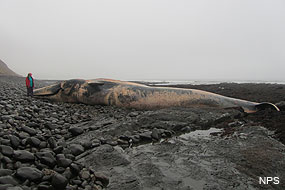|
Contact: John A. Dell’Osso, 415-464-5135

On Thursday, June 21, NOAA's National Marine Mammal Stranding Network (a group of agencies and organizations coordinated by the National Marine Fisheries Service) responded to a reported dead whale that washed ashore at Point Reyes National Seashore. The animal, a 47-foot male juvenile fin whale (Balaenoptera physalus), had earlier been identified by scientists on a NOAA research vessel as part of the Applied California Current Ecosystem Studies (ACCESS) cruise program; they were from PRBO Conservation Science and NOAA's Cordell Bank and Gulf of the Farallones National Marine Sanctuaries. On Thursday, June 21, scientists from the California Academy of Sciences and PRBO Conservation Science hiked out to the remote beach to conduct a post mortem, or necropsy, on the dead whale, but could not complete it due to its position in the surf zone. On Friday, June 22, just after dawn at low tide, scientists from Point Reyes National Seashore and veterinary staff from The Marine Mammal Center conducted a full necropsy. They concluded that the whale had been killed by ship strike. Injuries to the spine, ribs and other skeletal elements and tissues were extensive. "This is another dramatic example of negative human impact on marine mammals," said Dr. Frances Gulland, Senior Scientist at The Marine Mammal Center. "The spine of this whale was completely fractured as a result of a ship strike and it is very sad that this animal's life came to an end in this manner." Cordell Bank Superintendent Dan Howard noted the extreme rarity of fin whales in this area. "There have been only two previous live sightings of fins in the past 8-plus years of our ACCESS cruises, despite intensive effort; both occurred in 2004, and none since. However, a dead ship struck fin whale washed up from the Gulf of the Farallones onto San Francisco's Ocean Beach in the fall of 2010." It is not known where the whale was struck by a ship, but it likely occurred in the Gulf of the Farallones. Several endangered whale species have been feeding intensively off the north-central California coast in recent weeks, including blue, humpback, gray and now, apparently, fin whales. The abundance of krill--small shrimplike crustaceans--has attracted them, and when focused on feeding, whales often do not take measures to avoid oncoming ships. Causes for mortality are hard to identify but ship strikes have been reported several times as the cause of death in fin whales over the past decade. FIN WHALE FACTS: Also called the finback whale, razorback whale, or common rorqual, fin whales are federally listed as endangered under the Endangered Species Act and also protected under the Marine Mammal Protection Act and are rarely observed by land or sea the Gulf of the Farallones. They roam the oceans of the world but not in Polar Regions or near the equator. Fin whales are the second largest mammal on earth, after the blue whale, with females averaging 61 ft and males slightly smaller at 59 feet, but can attain lengths of nearly 90 feet. They are called the greyhounds of the sea because they are the fastest of all large whales, reaching speeds of 25 mph. The asymmetrical coloration of their lower jaw, mouth and baleen (cream colored on the right and black or olive colored on the left) is an extreme example of asymmetry in mammals and the easiest way to identify the species from other large whales. The fin whale is a filter-feeder, feeding on small schooling fish, squid, and crustaceans, including copepods and krill which they capture by lunging forward at speeds of up to 7 mph. They forage along the continental shelf break and the outer continental shelf but may venture near shore at promontories such as Point Reyes. Fin whales are divided into several populations worldwide and the population that occurs from Washington to California is estimated to be around 2,000 individuals. (http://www.nmfs.noaa.gov/pr/species/mammals/cetaceans/finwhale.htm). -NPS- |
Last updated: December 20, 2020
